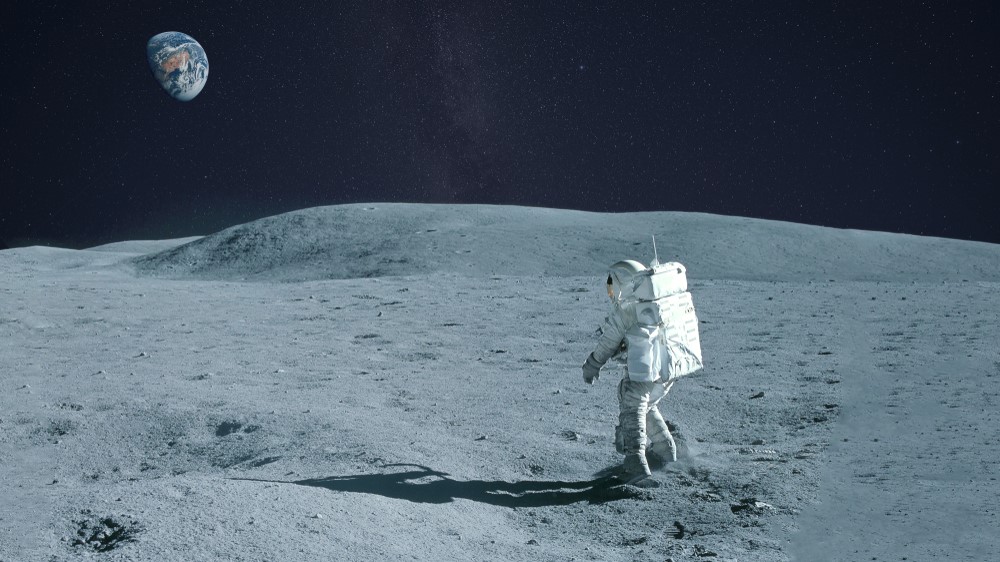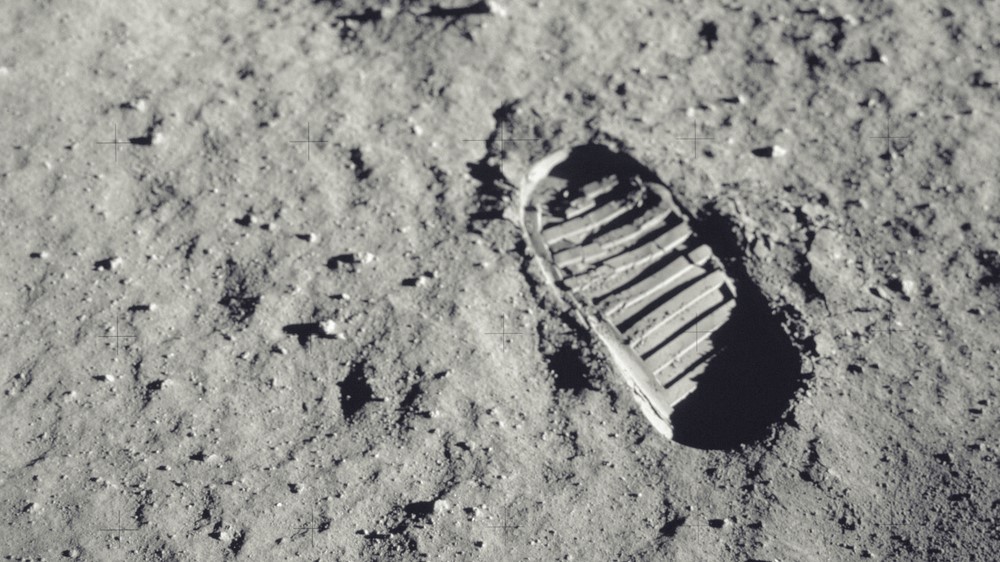How long would it take to walk around the moon?
It might be quicker than we originally believed, but it's a logistical nightmare.

From our vantage point on Earth, the moon looks small. But if you were to hop in a spaceship, don a spacesuit and go on an epic lunar hike, how long would it take to walk all the way around it?
The answer depends on myriad factors, including how fast you can go, how much time every day you spend walking, and what detours you'll need to take to avoid dangerous topography.
Such a trip around the moon could take longer than a year, but in reality, there are a lot more challenges to overcome.
Related: What messages have we sent to aliens?
A total of 12 humans have stepped foot on the lunar surface, all of whom were part of the Apollo missions between 1969 and 1972, according to NASA. The footage that was beamed back to Earth showed how challenging (and, apparently, fun) it was to walk — or more accurately, bounce — around in the moon's low gravity, which is one-sixth the gravity of Earth.
However, research from NASA has since suggested that it is possible for humans to maneuver much faster on the moon than the Apollo astronauts did. Theoretically, walking the circumference of the moon could be done faster than previously predicted.
Picking up the pace
During the Apollo missions, astronauts bounced around the surface at a casual 1.4 mph (2.2 km/h), according to NASA. This slow speed was mainly due to their clunky, pressurized spacesuits that were not designed with mobility in mind. If the "moonwalkers" had sported sleeker suits, they might have found it a lot easier to move and, as a result, picked up the pace.
Get the world’s most fascinating discoveries delivered straight to your inbox.
In 2014, a NASA study published in the Journal of Experimental Biology tested how fast humans could walk and run in simulated lunar gravity. To do this, the team got eight participants (three of which were astronauts) to use a treadmill onboard a DC-9 aircraft, which flew special parabolic trajectories on Earth to simulate gravity on the moon for up to 20 seconds at a time.
This experiment revealed that the participants were able to walk up to 3.1 mph (5 km/h) before breaking into a run. This is not only more than double the walking speed managed by the Apollo astronauts but also fairly close to the 4.5 mph (7.2 km/h) average maximum walking speed on Earth, according to the researchers.
The participants pulled off these fast speeds because they were able to freely swing their arms, similar to how humans run on Earth. This pendulum motion created a downward force, which partially compensated for a lack of gravity. One of the reasons the Apollo astronauts were so slow on the lunar surface was because they couldn't do this properly due their chunky suits.
At this new hypothetical max speed, it would take about 91 days to walk the 6,786-mile (10,921 km) circumference of the moon. For context, it would take around 334 days to walk nonstop (i.e., not stopping to sleep or eat) around the 24,901-mile (40,075 km) circumference of Earth at this speed, although it is impossible to do so because of the oceans.
Obviously, it's not possible to walk nonstop for 91 days, so the actual walk around the moon would take much longer.
Related: Why is space a vacuum?
Planning your route
Walking around the moon also poses a number of different challenges. "I think logistically, it could be done," Aidan Cowley, a scientific adviser at the European Space Agency, told Live Science. "But it would be a very strange mission to support."
One of the biggest challenges would be carrying supplies, such as water, food and oxygen.
"I don't think you'd be carrying them in your backpack," Cowley said. "Because that'd be far too much mass even, even if you're at one-sixth gravity."
Therefore, you would need to have a support vehicle with you, Cowley said. This vehicle could also double as shelter.
"A lot of the agencies are looking into the concept of having a pressurized rover, which can actually support the astronauts when they're doing exploration missions, kind of like portable mini-bases," Cowley said. "You could use that to go in at night and resupply and then go back out during the day and walk around again."
Moon adventurers would also need a spacesuit with a design that allows for optimal movement. Current spacesuits are still not created with excessive locomotion in mind, but some agencies are developing form-fitting suits that will allow for the arm swing necessary to walk properly on the moon, Cowley said.
The moon's harsh topography would also make finding a suitable route around it quite tricky, especially with meteor craters that can be several miles deep. "You would really want to go around [the craters]," Cowley said. "It's just too dangerous."
You would also have to factor in light and temperature when planning the route. "At the equator [of the moon], and during the day, you're looking at temperatures at around 100 degrees centigrade [212 degrees Fahrenheit]," Cowley said. "And then at nighttime, it drops to like minus 180 C [minus 292 F]."
The lunar cycle also means there are days when there is little or no sunlight, and at least half the journey would have to be done in the dark. Providing protection against these extreme temperatures could be possible with specially designed suits and the rover for protection, but the temperatures could also change the state of regolith — a fine gray soil that covers the moon's solid bedrock — and affect how fast you could walk on it, Cowley said.
Related: If you're on the moon, does the Earth appear to go through phases?
However, radiation could pose an even greater danger. Unlike Earth, the moon does not have a magnetic field that helps deflect radiation from reaching its surface.
"If there was no major solar activity at a time, then it may not be so bad," Cowley said. "But if there was a solar flare or coronal ejection and you're hit by high levels of radiation, that could make you very, very sick." (Solar flares and coronal mass ejections both release large amounts of energy and magnetized particles, but differ in the types of particles they emit, the duration of the event and the way the radiation they produce travels through space, according to NASA.)
This type of mission would also require a huge amount of endurance training because of the demands of exercising in low gravity on your muscles and cardiovascular system. "You'd have to send an astronaut with ultra-marathon-level fitness to do it," Cowley said.
Even then, walking at a top speed would be possible only for around three to four hours a day, Cowley said. So, if a person walked at 3.1 mph (5 km/h) for 4 hours a day, then it would take an estimated 547 days, or nearly 1.5 years to walk the moon's circumference, assuming your route isn't too disrupted by craters and you can deal with the temperature changes and radiation.
However, humans won't have the technology or equipment to accomplish such a feat until at least the late 2030s or early 2040s, Cowley said.
"You'd never get an agency to support anything like this," Cowley said. "But if some crazy billionaire wants to try it, maybe they can pull it off."
Originally published on Live Science.

Harry is a U.K.-based senior staff writer at Live Science. He studied marine biology at the University of Exeter before training to become a journalist. He covers a wide range of topics including space exploration, planetary science, space weather, climate change, animal behavior and paleontology. His recent work on the solar maximum won "best space submission" at the 2024 Aerospace Media Awards and was shortlisted in the "top scoop" category at the NCTJ Awards for Excellence in 2023. He also writes Live Science's weekly Earth from space series.





